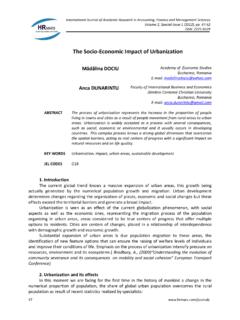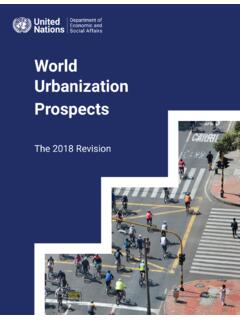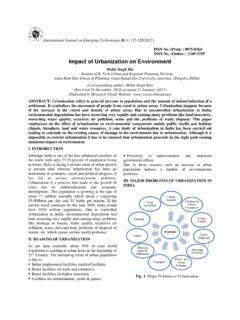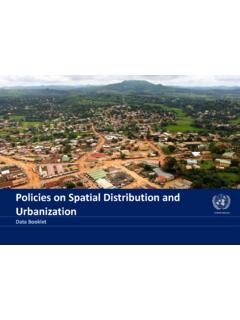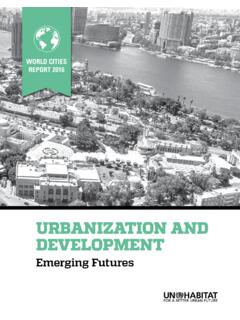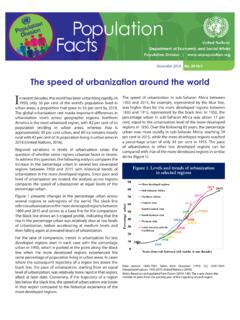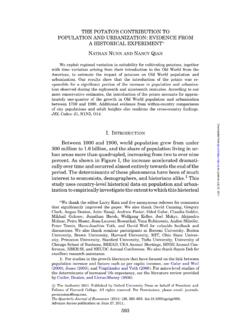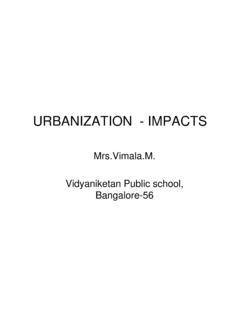Transcription of Sustainable Urbanization - United Nations
1 Sustainable Urbanization Thematic Think Piece UN Habitat The views expressed in this paper are those of the signing agencies and do not necessarily reflect the views of the United Nations . May 2012 2 Following on the outcome of the 2010 High-level Plenary Meeting of the General Assembly on the Millennium development Goals, the United Nations Secretary-General established the UN System Task Team in September 2011 to support UN system-wide preparations for the post-2015 UN development agenda, in consultation with all stakeholders. The Task Team is led by the Department of Economic and Social Affairs and the United Nations development Programme and brings together senior experts from over 50 UN entities and international organizations to provide system-wide support to the post-2015 consultation process, including analytical input, expertise and outreach.
2 3 Sustainable Urbanization 1. Introduction In the last quarter of 2011, the world population reached the seven billion mark. This historic event took place 12 years after the six billion mark. It took 123 years to double from one to two billion but only 33 years to cross the three-billion Although demographic growth is slowing down in the whole world, the fact that it has taken the ever-shortest time to add one extra billion signals a major shift in both the pace and scale of global demographics. An important facet of this shift is the historic milestone achieved in 2007 when more than half of the global population was living in cities and towns, thus making urban centres the dominant habitat for humankind.
3 This seemingly geographical shift has tremendous implications for the current and future dynamics of human development . The change in the dominant habitat of world population makes the process of Urbanization to be among the most significant global trends of the twenty-first century. Cities and urban places in general now occupy the centre stage in global development . They no longer function as mere spaces for settlement, production and services. They now profoundly shape and influence social and political relations at every level; determining advances and setbacks in modes of production; and providing new content to norms, culture and aesthetics.
4 Cities have become a major locus of power and politics consequently influencing vision achievement and dictating policy outcomes. They are also a major factor in environmental trends and sustainability processes. Urbanization is thus providing the setting, the underlying base, and also the momentum for global change. The shift towards a dominantly urban world is not simply a demographic phenomenon characterized by an anticipated population movement and change from one locale and profile to another. Rather it is a transformative process as well as a galvanizing momentum permeating many aspects of global development . It is also a dynamic which, if effectively 1 United Nations Department of Economic and Social Affairs, The World at Six Billion (New York, 1999), available at: 4 steered and deployed, can potentially serve as a force for enabling the world to overcome some of the current and future challenges.
5 The inclusion of the Urbanization factor in determining the post-2015 global development agenda is therefore fundamental if evolving positive processes, salient contextual factors, and the powerful momentum prevailing at this advent of the new millennium are to be harnessed. In addressing the Urbanization phenomenon, a post-2015 UN development agenda should go beyond the demographic dimension and should address the main challenges and opportunities that are shaping twenty-first century cities and towns, including how these affect and contribute to Sustainable development . Indeed, the demographics of Urbanization tend to project several critical elements which are important in defining the new agenda.
6 Most outstanding is the volume and rate of change at which the new human habitat is evolving. Interestingly, only 60 years ago or so (1950), the number of people living in urban centres was slightly higher in the developed Nations ( per cent, or million) compared to developing countries. By 1970, the proportion of people living in urban and rural areas was virtually equal at around 630 million. Today, of every 10 urban residents in the world more than seven are found in developing countries, which are also hosts to an overwhelming proportion of humankind (82 percent of the world s population). Moreover, of the 187,066 new city dwellers that will be added to the world s urban population every day between 2012 and 2015, per cent, or 171,213, will be born in a developing country.
7 Beneath the above numbers are questions of needs, demands and capacities to deliver for this large world population whose life base is fundamentally changing. Not only do new cities have to be built and managed differently, but a whole set of relations and ways of thinking about new agenda items will have to be developed. For example, the entire environmental agenda needs to be recast when the Urbanization dimension is factored in. Cities contribute to up to 70 per cent of the total greenhouse gas emissions. Currently, mobility systems within and between cities promote an excessive dependence on fossil fuel and building designs tend to overuse non-renewable resources.
8 The overall urban metabolism is totally unsustainable and it may worsen if no immediate action is taken. 5 The above elements, coupled with the current urban based and crisis-ridden modes of economic development underscore the need to pay attention to the Urbanization agenda. On this aspect, there are important lessons to be derived from recent experiences. On one hand, the negative imperative arising from mishandling an Urbanization element, such as the case of sub-prime lending, needs to be taken into account. Equally so, the opposite dynamism exhibited by emerging economies as they optimize on opportunities is an experience worthy of consolidation.
9 Other critical factors of Urbanization which will have a bearing on defining the new global agenda include the increasing urban sprawl; the rise of mega cities, increasing metropolitanization, emergence of urban corridors and regions all of which generate new demands, novel institutions, and will entail a profound overhaul in international relations. At the social level, some of the current concerns will continue to deserve priority attention. Poverty, this time dominantly urban, will be compounded by the rise of the new poor particularly in cities of industrial economies. The rising inequality in many parts of the world will generate tension and even conflict whose locus will be in cities and towns.
10 The issue of social inclusion will remain of prime concern as the infrastructure for global mobility improves but at the same time natural and human-made disasters increase. The political implications of immigration, particularly of the transnational variety, will have to be grappled with. 2. The City An Axis for the New Global Agenda A new positive agenda has to be designed for the post-2015 period. An agenda which capitalizes on the positive momentum, harnesses opportunities and builds on the transformative potential that the world is currently exhibiting. The city, as a pivotal node of the prevailing Urbanization dynamic, offers a critical axis for delivering the new agenda.










